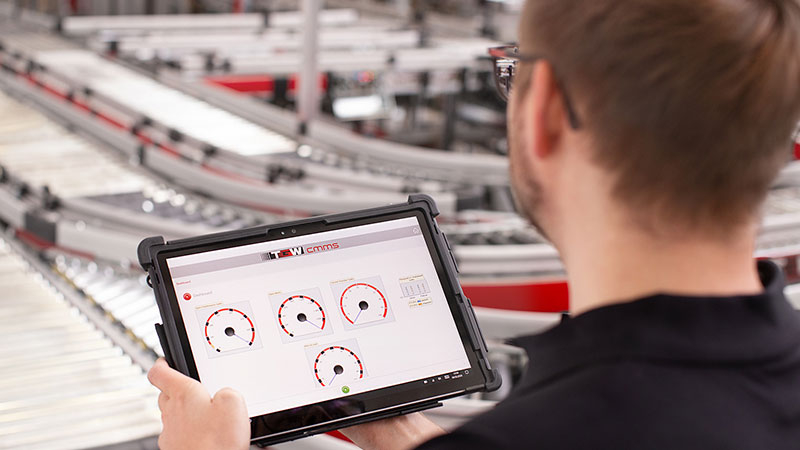- E-Commerce and new technology spur the retrofit market
- Sustainability is gaining increasing importance as a decisive criterion
- Seven factors decide retrofit project success
(Marchtrenk, 9 February 2022) Promising faster delivery and establishing resilient supply chains is only possible with state-of-the-art warehouse automation systems. Anyone planning a retrofit project needs to find a competent partner and to keep a few factors in mind.
It has now been 60 years since the opening of the first high bay warehouse (HBW). The trailblazer was Bertelsmann's "Book Silo," which went into operation in Germany in 1962. Since then, thousands of HBWs have been built and some of them have been going for decades. But whether HBWs or automated mini-load warehouses, after years in operation, practically no system still exists in the same form as it was when installed. Steel components may be sturdy, but IT and control elements, as well as mechatronics, must be regularly updated to be state of the art. And when product ranges, volumes, or customer demands change, modernization and expansion become necessary.
Adjustments, expansions, and modernization
Fundamentally, retrofit activities can be divided into three subcategories: adjustments, expansions, and modernization. The first subcategory consists of actions taken within months of a system being put into operation in order for the company to keep up with new market requirements. Expansions are particularly important for companies that experience strong growth after go-live. And regular modernization of the control systems and IT is generally necessary every four to five years because of technology changes. Usually, mechanical equipment is not due for upgrading for ten or more years.
E-commerce and automation
The growth of e-commerce has pushed companies to expand and automate their distribution efforts, leading to a growth in the retrofit market as well. TGW now handles almost five times as many retrofit projects annually as it did ten years ago. Another important driver is the competition for customer loyalty, which has led to promises of shorter and shorter delivery times over the years. As a result, companies have no choice but to establish a highly-automated, resilient supply chain. Unplanned downtimes are a nightmare for logistics managers, and long cycle times are a clear competitive disadvantage.
Putting off retrofitting has its risks. For one thing, spare parts could run out or technology could become unavailable. For another, knowledge could be lost over the years when, for example, the employees who know how to work with the current programming languages and control systems leave or retire.

Information in real time
Technology is changing faster than ever, requiring companies to gear up for the future. Even a simple software upgrade increases functionality, while a new warehouse management system enables better connectivity and more continuous data flow. On top of that, companies are more and more often looking to integrate autonomous technologies like automated guided vehicles or robots into their overall system. Adding such technology can only yield optimal results if the warehouse is running on state-of-the-art IT systems that are able to exchange information along the value added chain in real time.
Modern warehouse management systems now have the option of touchscreen controls, which are easier to use and require shorter training times. This is also true of the continuous zoom visualization option: these days, for example, users can zoom in down to the system's sensor level to find defective components. Maintenance is also faster and easier after a retrofit because of the improved technology and access to real-time data.

Sustainability as a decisive criterion
Since the subject of sustainability has come to the forefront of politics, society, and business, it has also become one of the drivers of retrofit projects. Generally speaking, these projects are inherently sustainable investments because they not only extend the lifespan of a company's systems but also increase the company's efficiency. Many companies are pursuing ambitious programs aimed at reducing emissions: they are more conscientious than ever about resources, carefully and thoroughly examining every link in their supply chain for potential reduction. In doing so, they delve deep into things like the energy consumption of different storage and retrieval machines or conveyor systems.
The bottom line is, companies should not debate whether or not to undertake a retrofit, but rather when and how. Of course they have to budget for it, but what is the alternative? If the competition can fulfill customer demands faster and better, one runs the risk of losing sales, and in this digital age the competition is no more than a click away. In the past, a customer would have been satisfied with one delivery containing 50 order lines. Today, that customer wants the same volume delivered to ten different places, at ten different times, just as they have come to expect from well-known direct to consumer channels. Looking at it that way shines a different light on investing in a retrofit and the corresponding return on investment.
TGW as an experienced partner
Once a company has recognized the need for a retrofit or an expansion, they need to find the right partner to carry it out. Over the course of its more than 52-year history, TGW has identified the central success factors for such projects:
The seven success factors for a retrofit project
- Consider the lead time and start early enough
- Choose experienced partners and project managers
- Develop a structured plan
- Integrate specially developed retrofit solutions
- Create a comprehensive functional specification
- Clearly define migration phases
- Intensive employee training

There are managers who assume they can wait until their systems are approaching the breaking point before considering upgrades. But they are forgetting that the lead time for a retrofit project can be up to a year and is sometimes longer now due to COVID. TGW approaches companies when their warehouse automation systems have reached 85 percent capacity so that a solution with the desired benefits can be developed in good time.
Choosing experienced partners and their project managers is necessary for defining a customized, structured plan that directly addresses growth needs. Experienced partners also know which products are specially designed for and best utilized in retrofit projects. They are able to create a comprehensive functional specification, and can establish clearly defined migration phases for faster and easier implementation.
Finally, employees need to be well trained. Employees need to know how to use the upgraded systems and on-site IT specialists and engineers must have a comprehensive understanding of all the changes.




